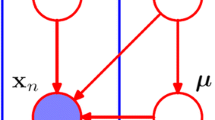Abstract
The Gaussian mixture model (GMM) is an efficient statistical tool successfully used in the computer vision community. In this paper, we expand the classical GMM to a novel model based on Markov random field (MRF) in the belief function framework for image segmentation tasks, named BM-GMM. The main advantage of BM-GMM is that it provides a convenient way to cluster data and requires a few parameters for optimization. Moreover, the proposed BM-GMM considers the spatial relationship between pixels via incorporating MRF to improve the robustness of the model against noise. The evidential membership allows the object to belong to the individual clusters and the meta-clusters composed of several collections. Therefore, the belief function theory has improved the GMM’s reliability for uncertainty analysis. Experimental results under various image datasets consistently demonstrated the proposed BM-GMM robustness, accuracy, and effectiveness.








Similar content being viewed by others
Data Availibility Statement
The datasets generated during and/or analysed during the current study are available from the corresponding author on reasonable request.
References
McLachlan, G.J., Lee, S.X., Rathnayake, S.I.: Finite mixture models. Annu. Rev. Stat. Appl. 6, 355–378 (2019)
Bishop, C.M.: Neural networks for pattern recognition. Oxford University Press (1995)
Ma, J., Jiang, J., Liu, C., et al.: Feature guided Gaussian mixture model with semi-supervised EM and local geometric constraint for retinal image registration. Inf. Sci. 417, 128–142 (2017)
Hassan, M., Murtza, I., Hira, A., et al.: Robust spatial fuzzy GMM based MRI segmentation and carotid artery plaque detection in ultrasound images. Comput. Methods Progr. Biomed. 175, 179–192 (2019)
Chen, Y., Cheng, N., Cai, M., et al.: A spatially constrained asymmetric Gaussian mixture model for image segmentation. Inf. Sci. 575, 41–65 (2021)
Forbes, F., Peyrard, N.: Hidden Markov random field model selection criteria based on mean field-like approximations. IEEE Trans. Pattern Anal. Mach. Intell. 25(9), 1089–1101 (2003)
Sun, J., Zhao, Y., Wang, S., et al.: Image compression based on Gaussian mixture model constrained using Markov random field. Signal Process. 183, 107990 (2021)
Kodamana, Z.L.H., Huang, A.A.B.: A GMM-MRF based image segmentation approach for interface level estimation. IFAC-PapersOnLine. 52(1), 28–33 (2019)
Peel, D., McLachlan, G.J.: Robust mixture modelling using the t distribution. Stat. Comput. 10, 339–348 (2000)
Ma, Y., Zhu, J., Tian, Z., et al.: Effective multiview registration of point clouds based on Student’s t mixture model. Inf. Sci. 608, 137–152 (2022)
Cheng, N., Cao, C., Yang, J., et al.: A spatially constrained skew Student’s t mixture model for brain MR image segmentation and bias field correction. Pattern Recogn. 128, 108658 (2022)
Li, J., Liu, K.Y., Hu, Y., et al.: Eres-UNet: liver CT image segmentation based on high-efficiency channel attention and Res-UNet++. Comput. Biol. Med. 158, 106501 (2023)
Zhang, X.F., Liu, Y.S., Guo, S.J., et al.: EG-Unet: edge-guided cascaded networks for automated frontal brain segmentation in MR images. Comput. Biol. Med. 158, 106501 (2023)
Zhang, Z.Y., Wang, Z.H., Yang, Z.K.: AdwU-Net: adaptive depth and width U-net for medical image segmentation by differentiable neural architecture search. PMLR 172, 1–14 (2022)
Shafer, G.: A mathematical theory of evidence. Princeton University Press (1976)
Xu, H., Deng, Y.: Dependent evidence combination based on decision making trial and evaluation laboratory method. Int. J. Intell. Syst. 34(7), 1555–1571 (2019)
Seiti, H., Hafezalkotob, A., Herrera-Viedma, E.: A novel linguistic approach for multi-granular information fusion and decision-making using risk-based linguistic D numbers. Inf. Sci. 530, 43–65 (2020)
Gong, C., Su, Z., Wang, P., et al.: Evidential instance selection for K-nearest neighbor classification of big data. Int. J. Approx. Reason. 138, 123–144 (2021)
Banfield, J.D., Raftery, A.E.: Model-based Gaussian and non-Gaussian clustering. Biometrics. 49, 803–821 (1993)
Author information
Authors and Affiliations
Contributions
All authors contributed to the study conception and design. The first draft of the manuscript was written by Tong Hou and all authors commented on previous versions of the manuscript. All authors read and approved the final manuscript.
Corresponding author
Ethics declarations
Conflict of interest
The authors have no relevant financial or non-financial interests to disclose.
Ethical approval
Not applicable.
Additional information
Publisher's Note
Springer Nature remains neutral with regard to jurisdictional claims in published maps and institutional affiliations.
H. Zhu: This work was supported by the National Nature Science Foundation of China under Grant 61872143.
Rights and permissions
Springer Nature or its licensor (e.g. a society or other partner) holds exclusive rights to this article under a publishing agreement with the author(s) or other rightsholder(s); author self-archiving of the accepted manuscript version of this article is solely governed by the terms of such publishing agreement and applicable law.
About this article
Cite this article
Hou, T., Zhu, H. & Yang, S. BM-GMM: belief function-based Gaussian Markov model for image segmentation. SIViP 17, 4551–4560 (2023). https://doi.org/10.1007/s11760-023-02690-0
Received:
Revised:
Accepted:
Published:
Issue Date:
DOI: https://doi.org/10.1007/s11760-023-02690-0




